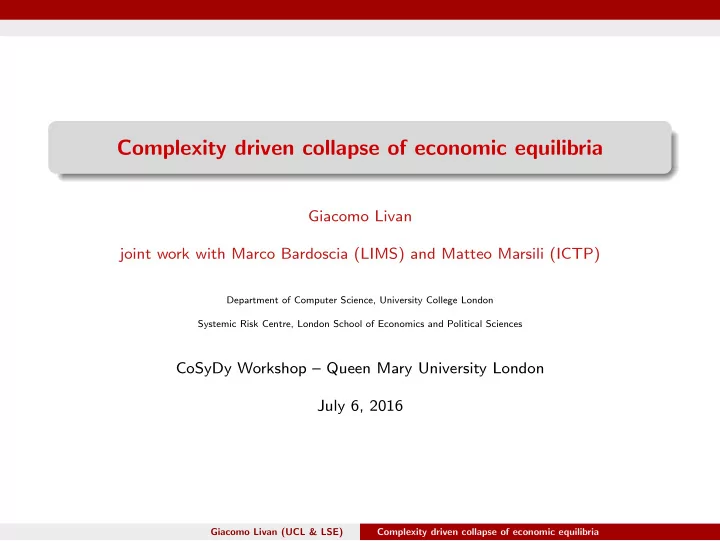

Complexity driven collapse of economic equilibria Giacomo Livan joint work with Marco Bardoscia (LIMS) and Matteo Marsili (ICTP) Department of Computer Science, University College London Systemic Risk Centre, London School of Economics and Political Sciences CoSyDy Workshop – Queen Mary University London July 6, 2016 Giacomo Livan (UCL & LSE) Complexity driven collapse of economic equilibria
Micro(economics) − → Macro(economics) ⋆ General problem: aggregating microeconomic behaviour and interactions between economic agents into macroeconomic laws ⋆ Specific problem: understanding the macroeconomic behaviour of modern industrialized economies ⋆ Input-output analysis: understanding the linkages and mutual impact between different productive entities output from sector / firm A − → input to sector / firm B Giacomo Livan (UCL & LSE) Complexity driven collapse of economic equilibria
Input-output analysis (I) Pre-industrial era: Tableaux ´ economiques (1758) Figure: Fran¸ cois Quesnay (1694-1774) Giacomo Livan (UCL & LSE) Complexity driven collapse of economic equilibria
Input-output analysis (II) ⋆ Economies have evolved to remarkable levels of complexity: the production of technologically sophisticated objects involves multiple production processes feeding each other, often delocalized / outsourced across multiple firms ⋆ Modern input-output models are written in the language of General Equilibrium (GE) Theory profit maximizing firms ← → utility maximizing consumers ���� market prices Giacomo Livan (UCL & LSE) Complexity driven collapse of economic equilibria
A GE input–output model (I) Ingredients: ⋆ C goods − Raw goods: x c 0 = 1 − Consumer goods: k c = 1 x c x c 0 = 1 0 = 0 k c = 1 k c = 0 ⋆ N technologies / firms − q c i < 0 : good c is an input to technology i − q c i > 0 : good c is an output of technology i Giacomo Livan (UCL & LSE) Complexity driven collapse of economic equilibria
A GE input–output model (II) Goal: determine an equilibrium price p c for each good such that ⋆ Firms maximize profits by optimizing their scales of production s i ≥ 0 ( “intensity” at which technologies are run) ⋆ Consumers maximize their utility function (consumption of consumer goods) given a budget constraint Problems of standard GE approach ⋆ No heterogeneity (representative consumer) ⋆ Reliance on precise knowledge of the economy’s input–output matrix q c i ⋆ Analytically intractable even for very small numbers of goods and firms Giacomo Livan (UCL & LSE) Complexity driven collapse of economic equilibria
GE meets Complexity ⋆ Solution: “promoting” interactions in the economy to random variables Systems with random interactions F. Dyson: “What is here required is a new kind of statistical mechanics, in which we renounce exact knowledge not of the state of the system but of the system itself.” ⋆ Methods: averaging over ensemble of economies in the limit N, C → ∞ with n = N/C finite − → Averaging over all possible input–output matrices and all possible representative consumers ⋆ Benefits of the approach 1) Analytical access to the economy’s typical properties 2) Solution expressed as interaction between a representative consumer and representative firm − → “Microscopic” justification for representative consumer assumption Giacomo Livan (UCL & LSE) Complexity driven collapse of economic equilibria
The economy’s phase diagram 0 . 60 ⋆ n = N C = # of technologies 0 . 48 # of goods h s ∗ i 0 . 36 0 . 24 ⋆ π = # raw goods 0 . 12 # of goods 0 . 00 1 . 0 ⋆ � s ∗ � = average scale of production 0 . 8 0 . 6 0 . 4 π 10 − 1 0 . 2 10 0 0 . 0 10 1 n ⋆ Result: Transition from no-industrialization trap to industrial production happens without need to invoke a “big push” ⋆ Result: introduction of new technologies has different impacts in different regimes Giacomo Livan (UCL & LSE) Complexity driven collapse of economic equilibria
Economic expansion through intermediate goods ⋆ Economies can expand via outsourcing / externalization, i.e. the creation of new markets for intermediate goods ⋆ Increase in the number of firms − → increase in the number of interactions through market prices − → increase in complexity! 5 pt Giacomo Livan (UCL & LSE) Complexity driven collapse of economic equilibria
Complexity driven collapse of equilibria 0.5 0.4 0.3 φ 0.2 0.1 0 0 0.2 0.4 0.6 0.8 1 I ⋆ φ = fraction of active technologies / firms ⋆ I = fraction of intermediate goods ⋆ Result: expansion of the economy via externalization / outsourcing leads to a sudden shutdown after a critical threshold is exceeded Giacomo Livan (UCL & LSE) Complexity driven collapse of economic equilibria
Remarks ⋆ Full solution of GE in a simple input-output setting ⋆ NOT our predictions → GE’s predictions! ⋆ Analytical treatment of combinatorial phase transition in high-dimensional geometry (see Donoho and Tanner (2009)) ⋆ Similar phase transition describes emergence of arbitrage opportunities from heterogeneity in pricing models M. Bardoscia, G. L., M. Marsili, J. Stat. Mech. (2012) ⋆ Preprint online at http://arxiv.org/abs/1511.09203 Giacomo Livan (UCL & LSE) Complexity driven collapse of economic equilibria
Recommend
More recommend